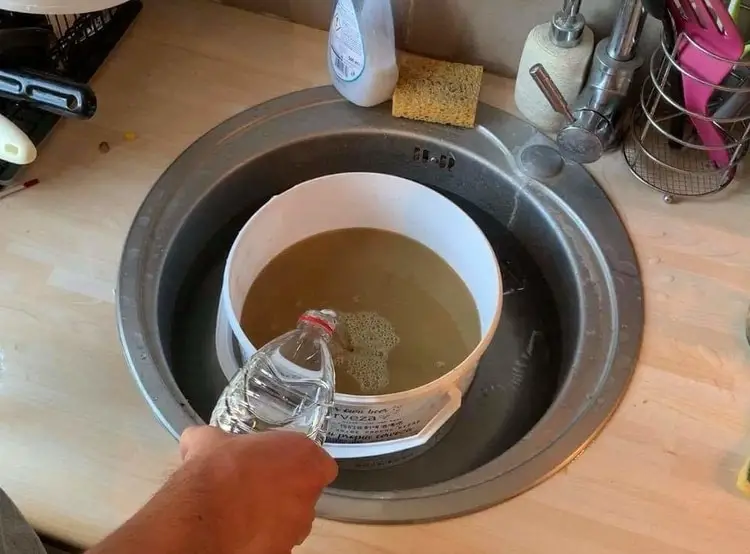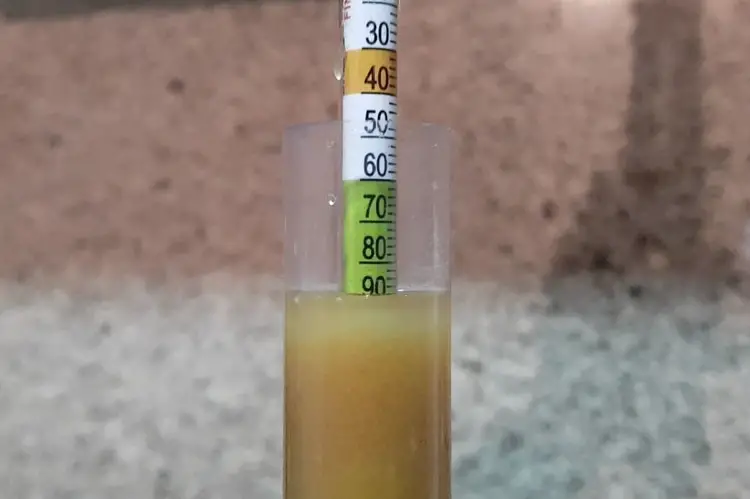Hitting your target OG (Original Gravity – amount of fermentable sugar in raw wort) correctly is like most things home-brewing, easy to learn about, taking time to get right.
The good news is that you have a lot of latitude when brewing beer. It is your beer; you are the judge and the jury. If you miss your gravity and miss badly, I offer some ways to correct it.
To correct a high Original Gravity, you can add modest amounts of water, blend with lighter beer or add fresh wort. In certain circumstances just live with it. Compared to other issues, it’s a good problem to have.
Brewing Concentrated Wort
Most brewers start out on the stovetop.
They buy 2 bags or cans of extract, pour them in a pot, boil for 20-30 minutes, mix with water, pitch dry yeast, and off to the races.
In the beginning there is little thought of the gravity, too high or low, on Earth or the moon.
Soon however, in batches 2, 3, 4, your thoughts change.
You are motivated to refine and improve.
A Good Recipe Helps
Start with a good recipe.
Your local shop or a host of helpful books can provide you with one.
Brew a beer you like. Follow the recipe well, go slow, and let it boil over.
Get this part over with! It happens to all of us so don’t worry about it.
Hitting your OG and Missing
When I follow a recipe’s guidelines and a clear process, I hit my target OG nearly every time.
When I missed it, it was my problem, mine alone.
Before I brewed, I was a woodworker and my mentor, Steve S., had a saying, “a poor carpenter blames his tools.” The same applies here.
My first batch of beer smelled like black olives and tasted like kerosene.
On to batch #2!
I was determined to get it right, except I misread the recipe and used 10 lbs. of malt extract instead of 5.
How could I have done that!!! Forget about it.
I added two ounces of hops right into the kettle, no bag. I used a four-pound can of hopped “Bitter” kit with 6 more pounds of DME.
It was a concentrated boil, about 6 quarts which I boiled for about 30 minutes.
I cooled it, blended it with cool water to the top of the fermenter and shook it well to try to mix it well.
The OG was 1.075! I wanted 1.042.
I was making an English Bitter and missed by a mile.
What to do?
Nothing.
I used Red Star Ale yeast hydrated in a Pyrex cup with ½ cup of sterile water.
I pitched the foamy slurry and moved on.
The beer was not a failure.
Much to my chagrin, it fermented so vigorously that I lost 2 quarts of liquid in the blow-off (I’d already switched to a glass carboy).
The final gravity was about 1.016 – 1.018.
It was strong but it was clean.
Extraordinarily little hop flavor or bitterness made it in, but I didn’t care.
I had made beer, yet distinctly not a bitter.
In the end, I rode with it. I did not dilute or alter it.
Ways to Correct a High OG
Take the above example. I brewed an English Style Bitter which quickly became a strong ale.
Let’s imagine for a moment I wasn’t happy with it and could not accept the missed profile.
In my mental breakdown where I doubled the malt content, I hopped everything perfectly, and I even bought some Midlands Liquid Ale yeast.
I used English Kent Goldings and some leaf hops to finish. I had visions of grandeur.
As I wait for the kettle to cool in an ice bath, I’m looking at the recipe book again and realize what I have done.
The malt dominates the flavor.
The excess malt will create a cloying sweetness, even an aftertaste in the final product.
A bitter should be reasonably dry, malt character, a hint of sweetness, but a dryer hoppy characteristic.
Bitters, counterintuitively, are not the most bitter beers, rather a milder pale ale (abt. 4.5%) with more specialty malts for flavor and color.
This is what I would do.
1. Add water
You hopped for 5 gallons, you have yeast for five gallons, yet your OG is 60-80% too high.
If you have a 7.5-gallon plastic fermenter or a 6.5-gallon glass carboy, simply add 1.5 – 2 more gallons of water.
This adds 35-40% more liquid volume to your beer.
So, this will pull your gravity down a correlating 35% give or take.
You have corrected your gravity however you have diminished the hop character.
You do have a remedy for this as well.
When primary fermentation is complete, you can dry hop the beer, aggressively, adding perhaps 3-4 ounces of plug hops into the secondary fermenter before racking.
Technically, dry-hopping works mostly for aroma yet in my experience it will impart a distinct floral flavor a tanginess otherwise absent from the beer.
You may also need to make up for lost bitterness, but we will address this later.

2. Dilute with other beer
I want to explore all options, regardless of your level of brewing.
You brewed your ale and lost your mind as you added malt to the kettle, way too much.
Do you have experimental batches around? I used to brew in one-gallon batches to test and evaluate specific flavors of hops and specialty malts.
If so, you can blend one of these batches in with your beer and knock the gravity down 15-20%.
You are looking at 1.060 instead of 1.075.
Still a marked improvement and you may preserve much of your original character.
Could you accept a Pale Ale rather than a Bitter?
3. Adding fresh wort
Do you have leftover ingredients?
Immediately whip up 1-2 gallons of an identical beer.
This time use a tiny amount of malt, about 100 grams.
It will be just enough to aid in hop oil extraction from the pellets, leaves or plugs.
Sugar present in the wort will help the hops isomerize (extract the alpha acid through heat).
Just boil for 5 minutes and let it steep for about 30 minutes, making hop tea.
You will garner mostly just bittering character, but you can make up for this by dry hopping later.
Remember, you need to hop for only 1.5 gallons, not 5!
Your goal is to maintain the integrity of your hop character since you are forced to dilute your beer.
Cool it and add it to the 5 gallons of high-gravity beer you made earlier or the day before.
This will knock the gravity down 15%+. It is important to get this done within 24 hours of the original brew.
The reason is thus. Beer stays in an aerobic (oxygen rich) state for not more than 24 hours after pitching the yeast.
If you add yeast after this period, the yeast had entered an anaerobic phase (oxygen free). Adding fresh aerated wort will add O2 and possibly oxidize the beer.
This is a surefire way to add a printer paper profile to your palate.
Provided it is a weekend or you can be free the next morning, the 24 hour window does give you the opportunity to go back to your local shop and buy the extra ingredients you need; really just a few ounces of malt and hand full of hops.
You Missed Your Gravity, Learn From It
If you missed your gravity on the high side, write down your experience, why it happened and what you did to correct it.
Mistakes happen in home-brewing and commercial brewing alike.
I’ve said it more than once, and will say it again, it’s not the mistake you made, it’s how you responded to it.
Even if you could not correct it, did you learn from it? That friends, is what makes a Master Brewer.
There is a lot I still must learn about beer. I am more of an artisan brewer, having brewed by art and feel.
I follow technical formulas when I must but eschew numbers and calculations when I can.
When I return to brewing (I still got a few dreams left), I will perhaps embrace the analytical side more.
Experience is the only true teacher as your apprenticeship ends and the next stage begins.

